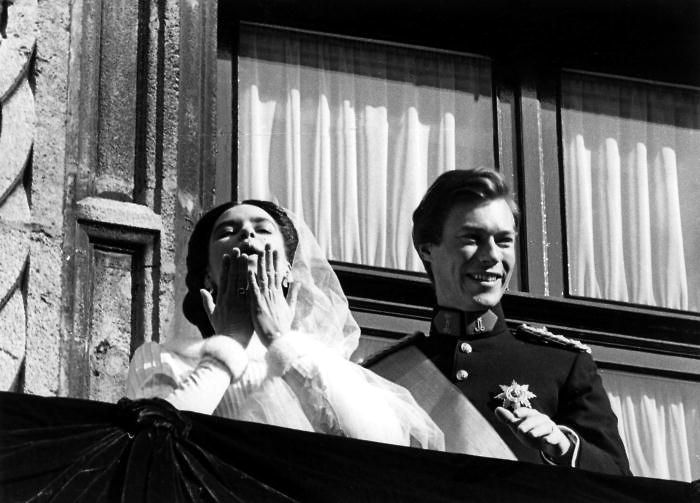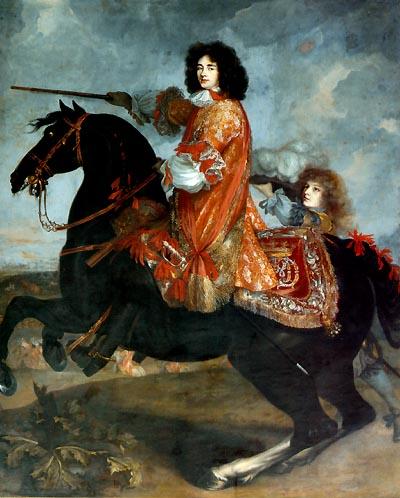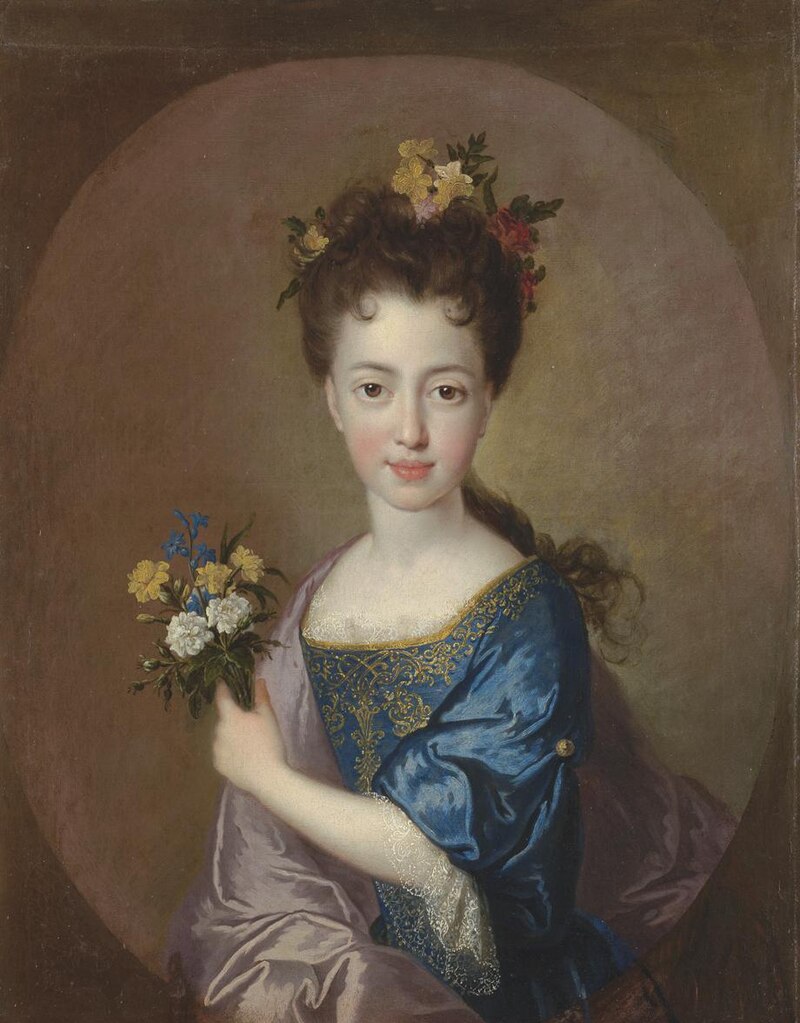by Emily McMahon © Unofficial Royalty 2017
Hereditary Grand Duke Henri of Luxembourg (the future Grand Duke Henri of Luxembourg) married Maria Teresa Mestre y Batista-Falla on February 14, 1981, in a civil ceremony at the Grand Ducal Palace in Luxembourg City, Luxembourg, and then in a religious ceremony at the Cathedral of Notre Dame also in Luxembourg City, Luxembourg.
Henri’s Early Life

Henri (on the right in the back row) with his parents and siblings in 1971; Credit – Wikipedia
Henri was born on April 16, 1955, the second child of Hereditary Grand Duke Jean of Luxembourg and his wife, the former Princess Joséphine-Charlotte of Belgium. Henri had an elder sister, Marie-Astrid, and later had three younger siblings – Jean, Margaretha, and Guillaume. All of the children were born at Betzdorf Castle, the family’s home in eastern Luxembourg. Like his parents, Henri was raised Catholic.
Henri started his education in Luxembourg, and later graduated from secondary school in France. He then attended Sandhurst in Berkshire to complete military training. Following his time at Sandhurst, Henri earned a bachelor’s degree in political science at the University of Geneva in 1980. Henri also completed several internships with companies in the United States during his last two years of university studies. Through his education, Henri became fluent in German, French, Luxembourgish, and English. He also understands some Spanish.
During the 1970s, the decline in steel production hit Luxembourg’s mills and economy hard. Henri made a decision at that time to pursue investment by other countries as a means of boosting Luxembourg’s economy. This contributed to his decision to complete his chosen course of study and completion of foreign internships.
For more information about Henri see:
Maria Teresa’s Early Life
Maria Teresa Mestre y Batista-Falla was born on March 22, 1956, in Marianao, Havana, Cuba. Her parents were Jose Antonio Mestre y Alvarez and Maria Teresa de Mestre, descendants of Spanish nobility. Although they held no titles, Maria Teresa’s family had made a considerable fortune in banking and maintained an estate in Santander, Spain. Maria Teresa and her two brothers Antonio and Luis and her sister Catalina were all raised Catholic.
Following the rise of Fidel Castro to power in Cuba, Maria Teresa fled the country with her family in 1959 to New York City. The family stayed there until 1965 when they moved briefly to their home in Spain and later Switzerland. Maria Teresa’s father established himself as a banker in Switzerland during the following years.
Maria Teresa attended the Marymount School and L’École française during her time in New York. After moving to Geneva, Maria Teresa continued her studies at the Marie-José Institute in Gstaad. She completed her secondary education at the Marie-Thérèse School in Geneva, graduating in 1975. Maria Teresa also attained Swiss nationality while she was in high school.
Maria Teresa then entered the Graduate Institute of International Studies (part of the University of Geneva) where she earned a Bachelor of Political Science in 1980. During her years at the university, Maria Teresa concentrated her attention on gerontology, the care of children with learning difficulties, and the challenges experienced by women in the workplace. Along with her native Spanish, Maria Teresa became fluent in German, French, English, Italian, and later Luxembourgish.
For more information about Maria Teresa see:
The Question of a Commoner Spouse

Henri, Maria Teresa, and the Luxembourg Princely Family at the time of the engagement; Photo Credit – www.luxarazzi.com
By the time Henri came of age, royals were still expected to find a spouse among other European royal families – or titled aristocracy if no suitable royal candidate existed. Henri’s own parents were rumored to have been involved with commoners before their own marriage – commoners they were allegedly forced to abandon to marry one another. But by the mid-1970s, royals with commoner spouses were becoming less unusual. The monarchs or heirs apparent were married to non-aristocratic spouses in all of the Scandinavian countries and in the Netherlands. Yet Jean and Joséphine-Charlotte still felt that the future grand duchess should be a royal or a noble.
Henri did have plenty of opportunities to meet a spouse whom his family would have found suitable. As with young royals of all generations, Henri was linked to other eligible princesses and nobles during his young adulthood. During his time at Sandhurst, Henri was rumored to be dating Princess Caroline of Monaco, then a student at St. Mary’s School in Berkshire. While the two were of similar age, royal, and Roman Catholic, Caroline later stated that she and Henri were never more than friends.
A few years later, Henri was linked to Catherine of Limburg-Stirum, a German noble and descendent of the Count of Paris. The two were seen together at a few weddings, but the relationship did not develop into anything serious.
Despite Maria Teresa’s accomplishments and the prominence of her family, Henri’s family was reportedly dismayed at his wish to marry her, as they had hoped he would choose a royal or noble spouse. There was also some question as to whether Maria Teresa was related to former Cuban dictator Fulgencio Batista (she is not), which could have affected her suitability as a consort.
But so determined Henri was to marry Maria Teresa that it was rumored that Henri offered to renounce his claim to the grand ducal throne in order to do so. When it was clear that Henri refused to consider a royal spouse, Jean and Joséphine-Charlotte finally relented and let the couple announce their engagement. However, years later Maria Teresa said that she and Joséphine-Charlotte had always had a difficult relationship.
Courtship and Engagement
Maria Teresa and Henri met while completing their studies in Geneva. Occasionally both would end up working on class projects together or in the same study groups. It is unknown exactly how long the two knew one another before dating, but it is known that their relationship blossomed out of a strong friendship. Maria Teresa later said of their courtship, “The more time we spent together it was more clear to us that we would spend our lives together.”
Luxembourg Minister of State Pierre Werner announced the engagement of Henri and Maria Teresa on November 8, 1980. The announcement was made three weeks after the couple had finished their studies at the University of Geneva and apparently a day after the engagement was considered official. The Luxembourg public had known nothing of the couple’s relationship up to this point.
Henri and his parents officially introduced Maria Teresa to the press two days after announcing their engagement. At that time, the two announced that a spring 1981 wedding was being planned, but that the exact date and location were not yet known. During the press conference, Maria Teresa wore her new engagement ring of yellow gold set with a cabochon ruby.
Wedding Attire

Maria Teresa and Henri on their wedding day. Photo credit: Royal Order of Sartorial Splendor
Henri wore the black single-breasted high-necked uniform for the religious wedding. He complimented the uniform with the orange sash and eight-pointed plaque of the Order of the Gold Lion of the House of Nassau, the highest order in Luxembourg. Around his waist was a tasseled orange belt. This outfit has since become Henri’s standard outfit for most formal occasions.
For her dress, Maria Teresa chose a design by the French house Balmain, known as a leader in French fashion following World War II. Balmain had dressed several Hollywood clients, as well as Queen Sirkit of Thailand. Balmain continues to be a popular designer for the grand ducal family and other royalty around the world.
Maria Teresa’s wedding dress was made of white silk embossed with an intricate pattern. The floor-length dress had rather simple lines, with a bell skirt and subtle leg-o-mutton sleeves. It featured a jewel neckline and fitted bodice, with the cuffs, collar, and hem of the dress trimmed in fur, fitting for a winter wedding. The dress also had a train that descended from the shoulders and extended about two meters, meeting the length of Maria Teresa’s veil. The lace-trimmed veil featured a blusher worn by Maria Teresa during her walk down the aisle and part of the wedding service.
Maria Teresa wore attached to her veil the Congo Diamond Tiara, brought to Luxembourg from Belgium by her mother-in-law, Belgian princess Josephine-Charlotte. Josephine-Charlotte had worn the tiara, a gift from the people of Congo, during her own wedding ceremony. Maria Teresa’s sisters-in-law, Marie-Astrid and Margaretha, each wore the tiara on their own wedding days, both in 1982.
Maria Teresa’s wedding dress was later used to make a new dress for the statue of Our Lady of Luxembourg, Comforter of the Afflicted. The dress was first displayed on the statue in 2012, just before the wedding of Maria Teresa’s and Henri’s son Guillaume to Belgian noble Stephanie de Lannoy.
Wedding Ceremonies

Henri and Maria Teresa signing their wedding license. Photo credit: redcarpetwedding.org
As per Luxembourg law, Henri and Maria Teresa were married in a civil ceremony at the Grand Ducal Palace on the morning of February 14, 1981. The simple ceremony was conducted by Luxembourg City’s Mayor Camille Polfer, a close friend of the family.
The religious service took place about an hour after the civil ceremony at the capital city’s Notre Dame Cathedral. Maria Teresa’s sister Catalina (wearing a blue lace dress that echoed the design of her sister’s) served as a bridesmaid. Maria Teresa’s father led his daughter down the aisle.
Of the wedding day, Henri later remarked:
“This day I will always remember as the day that was such great joy. I will not conceal that I was a little excited about the enormous appeal, which had found our wedding in the media. At that moment, but in which my fiancee walked into the cathedral, any nervousness was gone, and I knew that we would now be forever by two for the tasks that would put life and my function to us to overcome together. This moment is one of my best memories.”
Although the couple married on February 14, both Henri and Maria Teresa later said that they were unaware of the Valentine’s Day holiday as it was not widely celebrated in Luxembourg at the time. The date was chosen due to a state visit scheduled a few weeks later in Luxembourg. Henri and Maria Teresa did not want to wait any longer than they had to marry, so the wedding was scheduled for February.
Following the wedding, the couple emerged from the cathedral and walked under a tunnel made of swords. Members of the Luxembourg Army in dress uniform held the swords.
Reception and Balcony Appearance

Henri, with Maria Teresa blowing kisses to the crowd from the balcony of the Grand Ducal Palace. Photo credit: Wort.lu
Despite the cold weather, Henri and Maria Teresa returned to the Grand Ducal Palace to wave and guests. The newlyweds appeared on the balcony of the palace – adorned in red velvet for the occasion – with both sets of parents. The couple shared a hug and kiss just before Maria Teresa blew kisses to the crowd below. A reception followed for the 700 wedding guests in the Grand Ducal Palace.
Wedding Guests
Over 700 guests attended the wedding and reception. Some of the more prominent guests included:
- Grand Duke Jean and Grand Duchess Josephine-Charlotte of Luxembourg
- Grand Duchess Charlotte of Luxembourg
- Princess Marie-Astrid of Luxembourg
- Prince Guillaume of Luxembourg
- Princess Margaretha of Luxembourg
- Princess Elisabeth of Luxembourg, Duchess of Hohenburg
- Princess Marie-Adelaide of Luxembourg and Count Carl Josef Henckel of
Donnersmarck - Princess Marie-Gabrielle of Luxembourg and Count Knud of Holstein-Ledreborg
- Princess Alix of Luxembourg and Prince Antoine de Ligne
- King Olav V of Norway
- Hereditary Prince Hans-Adam and Hereditary Princess Marie Aglae of Liechtenstein
- King Baudouin and Queen Fabiola of Belgium
- Prince Albert and Princess Paola of Liege (Belgium)
- Prince Philippe of Belgium
- Princess Astrid of Belgium
- Prince Laurent of Belgium
- Queen Margrethe (Henri’s godmother) and Prince Henrik of Denmark
- Prince Rainier and Princess Grace of Monaco
- Prince Philip, Duke of Edinburgh
- Former Queen Marie-Jose of Italy
- Infanta Margarita of Spain and the Duke of Soria
- Princess Margriet of the Netherlands and Pieter van Vollenhoven
- Archduke Otto and Archduchess Regina of Austria
- Princess Christina of Sweden, Mrs. Magnuson, and Mr. Tord Magnuson
- Prince Franz of Bavaria
- Archduchess Margherita of Austria-Este
- Archduke Carl Ludwig and Archduchess Yolande of Austria
- Archduke Carl Christian of Austria
- Archduke Rudolph and Archduchess Anna Gabriele of Austria
- Princess Leonor of Brazil and Prince Michel de Ligne
- Prince Ludwig and Princess Irmingard of Bavaria
- Princess Francesca of Bourbon-Parma and Prince Eduard von Lobkowicz
- Prince Eric and Princess Lydia of Bourbon-Parma
- Prince Wauthier and Princess Régine de Ligne
- Antoine de Ligne
- Princess Christine de Ligne
- Princess Sophie de Ligne
- Princess Yolande de Ligne
- Princess Sophie von Hohenberg
- Countess Marie Charlotte Henckel von Donnersmarck
- Count Flemming and Countess Ruth of Rosenborg
- Countess Monica of Holstein-Ledreborg
- Countess Kamilla of Holstein-Ledreborg
- Countess Tatiana of Holstein-Ledreborg
- Countess Antonia of Holstein-Ledreborg
Children
Embed from Getty Images
Henri and Maria Teresa with their five children
Henri and Maria Teresa had five children:
- Guillaume, Hereditary Grand Duke of Luxembourg (born 1981), married Stéphanie de Lannoy
- Prince Félix of Luxembourg (born 1984), married Claire Lademacher
- Prince Louis of Luxembourg (born 1986), married Tessy Antony, divorced
- Princess Alexandra of Luxembourg (born 1991), married Nicolas Bagory
- Prince Sébastien of Luxembourg (born 1992)
This article is the intellectual property of Unofficial Royalty and is NOT TO BE COPIED, EDITED, OR POSTED IN ANY FORM ON ANOTHER WEBSITE under any circumstances. It is permissible to use a link that directs to Unofficial Royalty.







































































